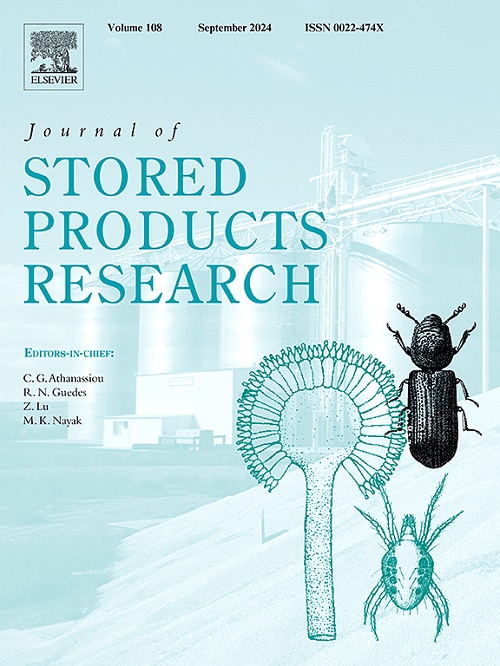香蒲精油对中国斑蝽的杀虫效果研究:基于生物测定和计算机分子对接的害虫可持续治理综合方法
IF 2.7
2区 农林科学
Q1 ENTOMOLOGY
引用次数: 0
摘要
虫害造成的收获后损失对全球粮食安全构成了重大威胁,尤其是食蚜蝇(Callosobruchus chinensis)。虽然合成杀虫剂的功效已得到证实,但其对环境和健康的影响突出表明需要更安全的替代品。本研究调查了Cymbopogon khasianus(CKEO)和Cymbopogon flexuosus(CFEO)的精油对矢车菊的杀虫特性。结果表明,CKEO和CFEO对矢车菊成虫具有相当的熏蒸毒性和驱避特性。值得注意的是,CFEO在所有测试浓度下都表现出更强的毒性,96小时的半数致死浓度值从86.81 μL/L到27.50 μL/L,而CKEO的半数致死浓度值从187.86 μL/L到52.97 μL/L。在驱避试验中,CKEO 在较低浓度(16.13 μL/L)下效果显著,在 13.13 μL/L 时达到 33.33 % 的驱避率,而 CFEO 在较高浓度(48.39 μL/L)下的表现优于 CKEO,在 6 小时后达到 93.通过气相色谱-质谱(GC-MS)鉴定出的主要植物化学物质中,反式-甲基异丁香油酚(43.16 %)和柠檬醛(34.56 %)分别是 CKEO 和 CFEO 中的主要化合物。分子对接研究表明,氧化香叶醇对昆虫 α 淀粉酶有很强的抑制潜力,其结合亲和力为 -7.62 kcal/mol。此外,对樟脑与气味受体的结合亲和力为-9.08 kcal/mol,与 NADH 氧化还原酶的结合亲和力为-7.30 kcal/mol,这表明对樟脑精油在生物化学相互作用中具有潜在的功能意义。将生物测定技术与分子对接技术相结合,揭示了其有效性背后的机制,为可持续害虫管理策略提供了重要的见解。本文章由计算机程序翻译,如有差异,请以英文原文为准。

Insights into insecticidal efficacy of Cymbopogon essential oils against Callosobruchus chinensis: An integrated approach through bioassays and in-silico molecular docking for sustainable pest management
Post-harvest losses attributed to insect pests, particularly Callosobruchus chinensis, pose a significant threat to global food security. Although synthetic pesticides have proven efficacy, their environmental and health implications highlight the need for safer alternatives. This study investigates the insecticidal properties of essential oils from Cymbopogon khasianus (CKEO) and Cymbopogon flexuosus (CFEO) against C. chinensis.
The results demonstrate that CKEO and CFEO possess considerable fumigant toxicity and repellent properties against adult C. chinensis. Notably, CFEO exhibited enhanced toxicity across all concentrations tested, with LC50 values ranging from 86.81 μL/L to 27.50 μL/L over 96 h, whereas CKEO showed LC50 values of 187.86 μL/L to 52.97 μL/L. In repellent assays, CKEO was notably effective at lower concentrations (16.13 μL/L), achieving 33.33 % repellency at 13.13 μL/L, while CFEO outperformed CKEO at higher concentrations (48.39 μL/L), reaching 93.33 % repellency after 6 h of exposure.
Among the key phytochemicals identified through GC-MS, trans-Methylisoeugenol (43.16 %) and Citral (34.56 %) were the predominant compounds in CKEO and CFEO respectively. Additionally, both oils contained other significant monoterpenes and sesquiterpenes, recognized for their substantial contact toxicity and repellent properties.
Molecular docking studies indicate that Caryophyellene oxide has a strong inhibitory potential against insect α-amylase, with a binding affinity of -7.62 kcal/mol. Furthermore, p-Camphorene shows notable binding affinities of -9.08 kcal/mol for odorant receptors, and -7.30 kcal/mol for NADH oxidoreductase, indicating its potential functional significance in biochemical interaction.
These findings highlight Cymbopogon essential oils as effective and sustainable pest management alternatives. Integrating bioassay techniques with molecular docking, reveals the mechanisms behind their effectiveness, providing important insights vital for sustainable pest management strategies.
求助全文
通过发布文献求助,成功后即可免费获取论文全文。
去求助
来源期刊
CiteScore
5.70
自引率
18.50%
发文量
112
审稿时长
45 days
期刊介绍:
The Journal of Stored Products Research provides an international medium for the publication of both reviews and original results from laboratory and field studies on the preservation and safety of stored products, notably food stocks, covering storage-related problems from the producer through the supply chain to the consumer. Stored products are characterised by having relatively low moisture content and include raw and semi-processed foods, animal feedstuffs, and a range of other durable items, including materials such as clothing or museum artefacts.

 求助内容:
求助内容: 应助结果提醒方式:
应助结果提醒方式:


